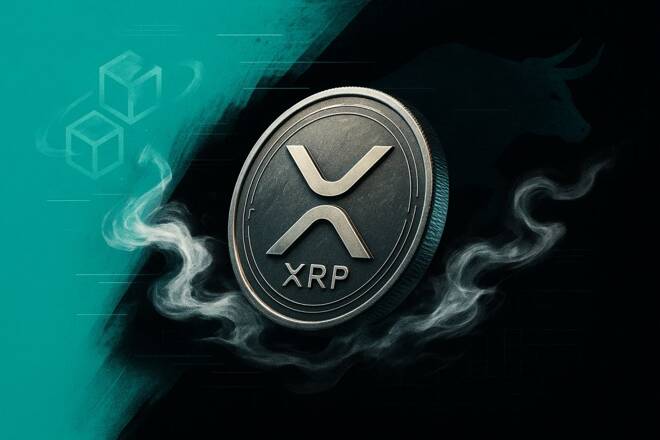Advertisement
Advertisement
XRP News Today: Bulls Eye Breakout With Senate Bill and Spot ETF Catalysts
By:
Key Points:
- Bipartisan support for the Market Structure Bill signals a major shift in U.S. crypto regulation.
- XRP surged 14.7% on July 17 after the House passed the bill, fueling hopes of a breakout beyond $3.66.
- ETF inflows, legislation, and Ripple’s bank license bid could influence XRP’s path toward new record highs.
Market Structure Bill Gets Bipartisan Support
XRP and the broader crypto market have enjoyed a marked shift in US lawmakers’ attitudes toward crypto since Trump’s re-election in November 2024. SEC Chair Gensler’s resignation, the end to the SEC v Ripple case, the passing of the GENIUS Act, and the launch of a US XRP ETF signaled an end to the Biden administration – Gensler’s anti-crypto era.
The next key legislation for the US digital asset space is the Market Structure Bill. The bill would deliver a much-needed regulatory framework, crucially removing the threat of future SEC lawsuits on the premise of breaching US securities laws.
The bill will give the CFTC greater regulatory oversight and provide the necessary framework to classify crypto as digital commodities or investment contracts, i.e., securities.
Crypto America host and journalist Eleanor Terrett shared the latest developments on Capitol Hill, stating:
“Senate Dems say they want to work with their Republican colleagues to ‘move forward quickly’ on bipartisan market structure legislation.”
Senator for Arizona, Ruben Gallego, shared a joint statement from 12 democratic senators on market structure legislation, which stated:
“Last week, we released a framework on market structure legislation, highlighting our desire to work on this issue. As we stated then, digital assets are a $4 trillion global market that will require a considered and bipartisan approach to regulation. We hope our Republican colleagues will agree to a bipartisan authorship process, as is the norm for legislation of this scale.”
The Senators underscored the need to move swiftly with bipartisan collaboration, adding:
“Given our shared interest in moving forward quickly on this issue, we hope they will agree to reasonable requests to allow for true collaboration.”
Digital Asset Framework: The Seven Pillars
The joint statement followed the release of its framework for digital asset legislation, comprising seven pillars, including:
- Closing the gap in the spot market for non-security digital assets.
- Clarifying the legal status of digital assets and regulator jurisdiction.
- Incorporating Digital Asset Issuers into the Regulatory Framework.
- Incorporating Digital Asset Platforms into the Regulatory Framework.
- Preventing Illicit Finance.
- Preventing Corruption and Abuse.
- Ensuring Fair, Effective Regulation.
Notably, the press release coincided with the launch of an XRP ETF, the first in the US. A clear regulatory framework fostering innovation while protecting investors could fuel adoption, potentially sending XRP to new highs.
On July 17, XRP soared 14.7% after the US House of Representatives passed the Market Structure Bill, sending it to the Senate. The bill’s progress, alongside the launch of XRP-spot ETFs, could send the token beyond its July 18 all-time high of $3.66 (Binance).
Price Action & Technical Analysis: Breakout to $3.2 Brings $3.66 into Play
XRP fell 0.5% on Saturday, September 20, following the previous day’s 2.67% loss, closing at $2.9775. The token underperformed the broader market (+0.3%) but continued trading close to the psychological $3 level. Traders are watching the following technical levels:
- Support: $2.8 and $2.5.
- Resistance: $3, $3.2, $3.335, and the all-time high at $3.66.
In the near term, several key events could drive price action:
- ETF flow trends.
- Spot ETFs: Approval or delays of XRP-spot ETFs and BlackRock’s plans for an iShares XRP Trust filing.
- Blue-chip companies’ views on XRP as a treasury reserve asset.
- Regulatory milestones: Ripple’s US-chartered bank license application, the Market Structure Bill, and SWIFT news may further influence demand.
Catalysts & Scenarios
XRP’s price outlook hinges on whether institutional inflows and regulatory approvals align, or if headwinds dominate.
Bearish Scenario
- BITW, GDLC, and XRPR register weak inflows, and BlackRock downplays the chances of an iShares XRP Trust filing.
- SEC declines XRP-spot ETF applications.
- Legislative disagreements or barriers to crypto-friendly regulations.
- Blue-chip companies avoid XRP as a treasury reserve asset.
- OCC delays or rejects Ripple’s US-chartered bank license.
- SWIFT maintains global dominance, capping Ripple’s market access.
These bearish events could push XRP toward $2.8, exposing $2.5, the next key support level.
Bullish Scenario
- BITW, GDLC, and XRPR report strong inflows.
- BlackRock submits an iShares XRP Trust application, and the SEC approves XRP-spot ETFs.
- Blue-chip companies embrace XRP as a treasury reserve asset, and more payment platforms integrate Ripple technology.
- Ripple secures a US-chartered bank license, and the Senate passes the Market Structure Bill.
- SWIFT loses market share of global remittances to Ripple.
These events could send XRP above $3, paving the way to $3.2. A sustained break above $3.2 could open the door to testing $3.335. A break above $3.335 may enable the bulls to target the record high of $3.66 (Binance).
Conclusion: Will ETF Flows and Legislation Boost XRP?
XRP is at a pivotal juncture. Spot ETF approvals and the Market Structure Bill could propel the token to new highs, while setbacks in regulation may push it back toward key support levels.
Analysts will closely monitor how regulatory and economic risks affect XRP’s trajectory in the coming weeks.
About the Author
Bob Masonauthor
With over 28 years of experience in the financial industry, Bob has worked with various global rating agencies and multinational banks. Currently he is covering currencies, commodities, alternative asset classes and global equities, focusing mostly on European and Asian markets.
Advertisement
